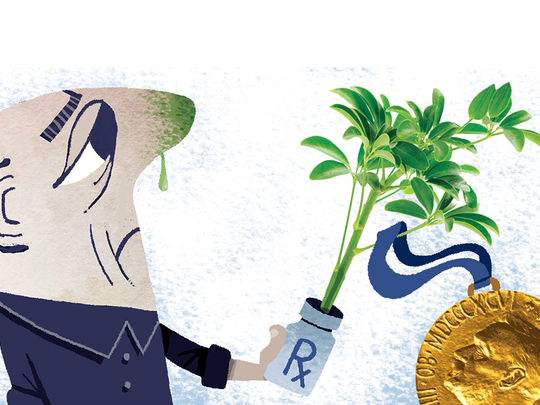
When the 2015 Nobel Prize in Physiology or Medicine was announced a few weeks ago, the scientific community had a collective gasp: half of the award was given to Youyou Tu, a Chinese researcher who had spent her entire career investigating and developing remedies from traditional medicine. Indeed, her prize-worthy contribution to medicine was the development of artemisinin as an “alternative” cure for malaria, especially since its standard treatment, chloroquine, was proving less and less effective as the parasites became drug-resistant.
Thus, many asked: Is traditional medicine respectable now in modern science and considered worthy of the highest prizes? But as often in such situations, the answer is not a simple yes or no.
First, traditional medicine includes a host of practices and can be given a variety of definitions. Very often, it is understood as “folk medicine”; remedies and practices that have been found to help in certain illnesses by various communities and got passed down from one generation to another, mostly verbally but sometimes recorded in manuals that people could go back to and share. That knowledge includes a long list of herbal medicines and therapeutic activities. Today, it is estimated that about half the world’s population uses folk medicine as primary treatment for various illnesses.
But nowadays, ‘traditional medicine’ has come to also signify ‘alternative medicine’ (or ‘complementary’ or ‘integrative’ medicine), which includes any treatments that your regular doctor at the hospital will not prescribe, such as homeopathy, osteopathy, and acupuncture. The prevalence of these practices remains quite low outside of their original communities (e.g. China); in the US, for instance, a recent survey found that only 1.5 per cent of the population had used acupuncture the previous year, a rate that hasn’t changed in recent times. One must note that some studies have found these particular practices to fare no better than placebos.
The Arab world is known to have developed — and to some extent preserved — a herbal traditional medicine. Going back to the heydays of the Arabic-Islamic civilisation, great physicians, botanists, and pharmacists such as Ibn Sina, Al Razi, and Ibn Al Baitar had not only written treatises and textbooks on various illnesses and treatments but also developed novel methods to produce complex drugs. To this day, in markets around the region, some shops specialise in selling herbs and mixtures that are made for the treatment of this or that sickness or are simply known to have a positive effect on one’s physical health or mental condition.
Some plants have acquired a quasi-mythical status on what they are claimed to achieve. Chief among them is al habba al sawda (the black caraway seed), which has been claimed to cure everything. Other herbs with (presumed) quasi-universal benefits include zaatar (thyme), za’faran (saffron), yansoon (aniseed), kamoon (cumin), and rumman (pomegranate). The illnesses they purport to cure range from the common cold, headaches and toothaches, to stomach pain (from indigestion to ulcers), anaemia and rheumatism.
Encyclopaedia of medicinal plants
And around the world today, there are research centres that investigate the benefits of such herbs and traditional therapeutic prescriptions. In the UAE, for instance, the Zayed Complex for Herbal Research and Traditional Medicine was established in 1996, and an ‘encyclopaedia of medicinal plants of the UAE’ was recently published by the Health Authority of Abu Dhabi. The Zayed Complex aims to promote an interdisciplinary research approach that combines traditional systems of medicine with modern scientific research methodology.
This last point (the “modern scientific research methodology”) is really the key to ensuring that traditional medicine is correctly developed, promoted and brought to fruition, in total distinction from the quackery that often characterises “alternative” or “complementary” medicine. And that kind of rigorous and solid scientific methodology is what the Nobel Prize committee has intended to emphasise by recognising Dr Tu with the highest award in the world. Indeed, Dr Tu spent years extracting, analysing and then testing the artemisinin product (or active ingredient) from the Chinese herb artemisia annual. The investigation process followed the highest standards of scientific, clinical studies, before it was used on patients.
Many people assume that just because some products are “natural”, such as herbs and plants, they are safe and good. But there are many poisonous plants and numerous herbs that have all kinds of side effects. And not all “natural” products are good for everyone; their effects depend on people’s bodies and personal conditions. Indeed, the World Health Organisation has warned that “inappropriate use of traditional medicines or practices can have negative or dangerous effects” and stressed that “further research is needed to ascertain the efficacy and safety” of various medicinal plants and therapeutic practices. And that is why more than 100 countries have set regulations on traditional medicinal products and practices.
To make a long story short, there is no doubt that traditional, particularly herbal medicine can be a source of new and beneficial remedies and drugs. However, the development of the field and the usage of its products and therapies must be subjected to rigorous scientific guidelines and regulations.
Nidhal Guessoum is a professor of physics and astronomy at the American University of Sharjah. You can follow him on Twitter at: www.twitter.com/@NidhalGuessoum.








